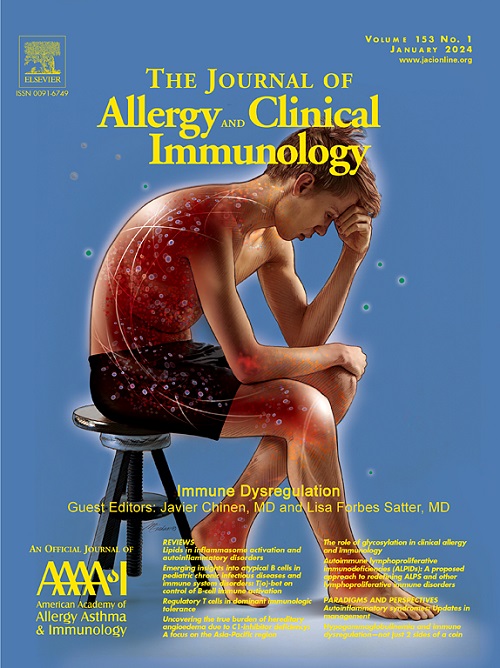Complement factor I deficiency–associated neuroinflammatory disease among Old Order Amish
IF 11.2
1区 医学
Q1 ALLERGY
引用次数: 0
Abstract
Background
Complement factor I (CFI) deficiency is an ultrarare inborn disorder of complement regulation that manifests with protean infectious, vasculitic, and neuroinflammatory symptoms.
Objective
We sought to functionally validate a previously unrecognized, disease-associated CFI variant (Y459S) and determine variant enrichment in the Old Order Amish population.
Methods
Expression and function of the CFI Y459S variant was evaluated via immunoblot, complement factor 3b degradation, and crystal structure analysis. CFI variant frequencies in Old Order Amish populations were determined using genomic databases hosted by the Clinic for Special Children and the Anabaptist Variant Server. Patient samples were assessed for leukocyte frequencies, cytokine concentrations, and complement component concentrations in clinical laboratories. Neuroinflammatory assessments were made by review of brain and spine magnetic resonance imaging by a blinded neuroradiologist.
Results
Y459S conferred a loss of function to CFI. The CFI Y459S allele is enriched more than 4500-fold among the Old Order Amish (mean allelic frequency, 0.037), with 1 in every 730 live births in this population predicted to be homozygous. A single-center cohort of 11 Amish CFI Y459S homozygous patients identified 5 patients with critical neuroinflammatory diagnoses including acute disseminated encephalomyelitis, transverse myelitis, and aseptic meningoencephalitis. Features of CFI-deficient neuroinflammation included neutrophilic cerebral spinal fluid pleocytosis, constitutive complement activation, female predominance, diverse neuroimaging findings, and (in 1 case) a clinical response to eculizumab.
Conclusions
CFI deficiency should be a key diagnostic consideration for patients with neuroinflammatory symptoms, neutrophilic cerebral spinal fluid pleocytosis, and complement consumption, especially if they belong to the Old Order Amish community.
老秩序阿米什人补体因子I缺乏相关的神经炎性疾病
补体因子I (CFI)缺乏症是一种极其罕见的先天性补体调节疾病,表现为蛋白感染性、血管血管和神经炎症症状。目的对一种以前未被识别的疾病相关CFI变异(Y459S)进行功能验证,并确定旧秩序阿米什人群中变异的富集程度。方法采用免疫印迹法、补体因子3b降解法、晶体结构分析等方法对Y459S CFI变异体的表达和功能进行评价。使用由特殊儿童诊所和再洗礼派变异服务器托管的基因组数据库确定旧秩序阿米什人群的CFI变异频率。在临床实验室评估患者样本的白细胞频率、细胞因子浓度和补体成分浓度。神经炎症评估是由盲神经放射科医生通过复查脑和脊柱核磁共振成像进行的。结果sy459s导致CFI功能丧失。CFI Y459S等位基因在旧秩序阿米什人(平均等位基因频率= 0.037)中富集了45500倍,预计每730个活产婴儿中就有1个是纯合子。一项由11名Amish CFI Y459S纯合子患者组成的单中心队列研究发现,5名患者具有严重的神经炎症诊断,包括急性播散性脑脊髓炎、横断面脊髓炎和无菌性脑膜脑炎。cfi缺陷性神经炎症的特征包括中性粒细胞性脑脊液多胞症、组成性补体激活、女性优势、不同的神经影像学发现,在一个病例中,对eculizumab有临床反应。结论cfi缺乏应作为神经炎症症状、中性粒细胞性脑脊液增多症和补体消耗患者的关键诊断考虑因素,特别是如果他们属于Old Order Amish社区。
本文章由计算机程序翻译,如有差异,请以英文原文为准。
求助全文
约1分钟内获得全文
求助全文
来源期刊
CiteScore
25.90
自引率
7.70%
发文量
1302
审稿时长
38 days
期刊介绍:
The Journal of Allergy and Clinical Immunology is a prestigious publication that features groundbreaking research in the fields of Allergy, Asthma, and Immunology. This influential journal publishes high-impact research papers that explore various topics, including asthma, food allergy, allergic rhinitis, atopic dermatitis, primary immune deficiencies, occupational and environmental allergy, and other allergic and immunologic diseases. The articles not only report on clinical trials and mechanistic studies but also provide insights into novel therapies, underlying mechanisms, and important discoveries that contribute to our understanding of these diseases. By sharing this valuable information, the journal aims to enhance the diagnosis and management of patients in the future.

 求助内容:
求助内容: 应助结果提醒方式:
应助结果提醒方式:


